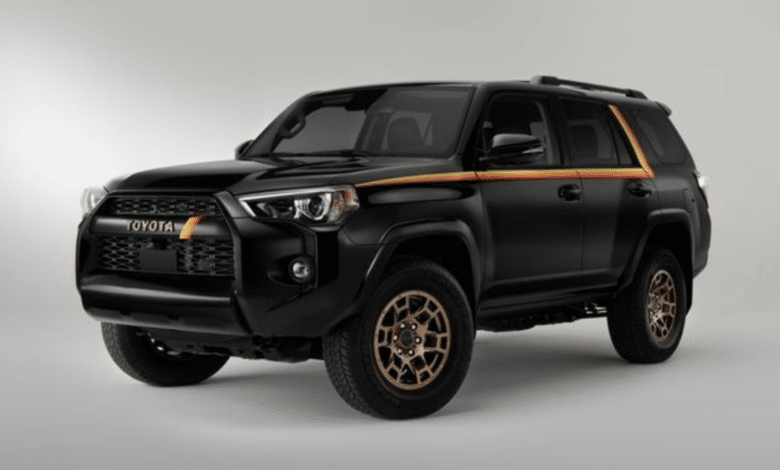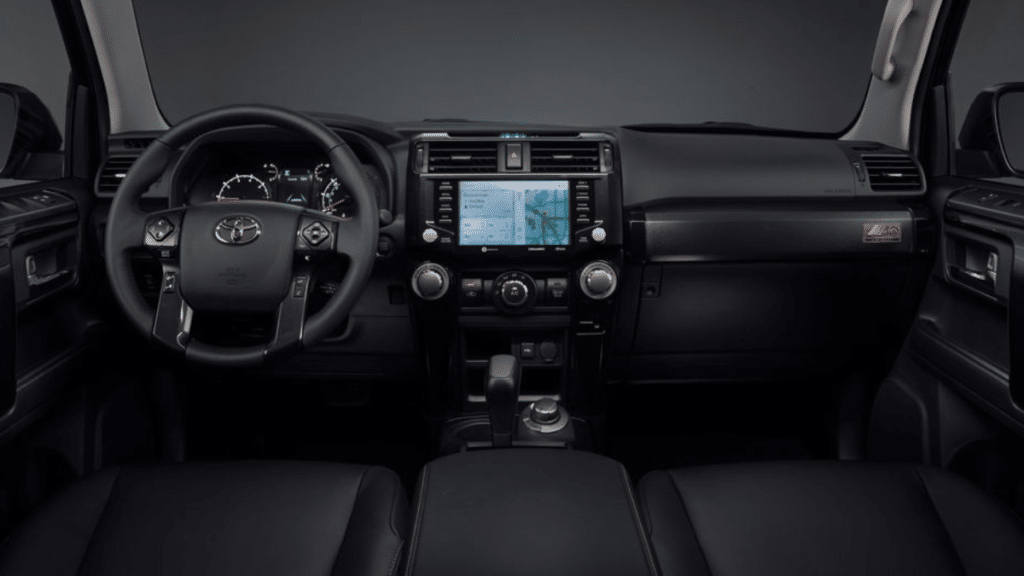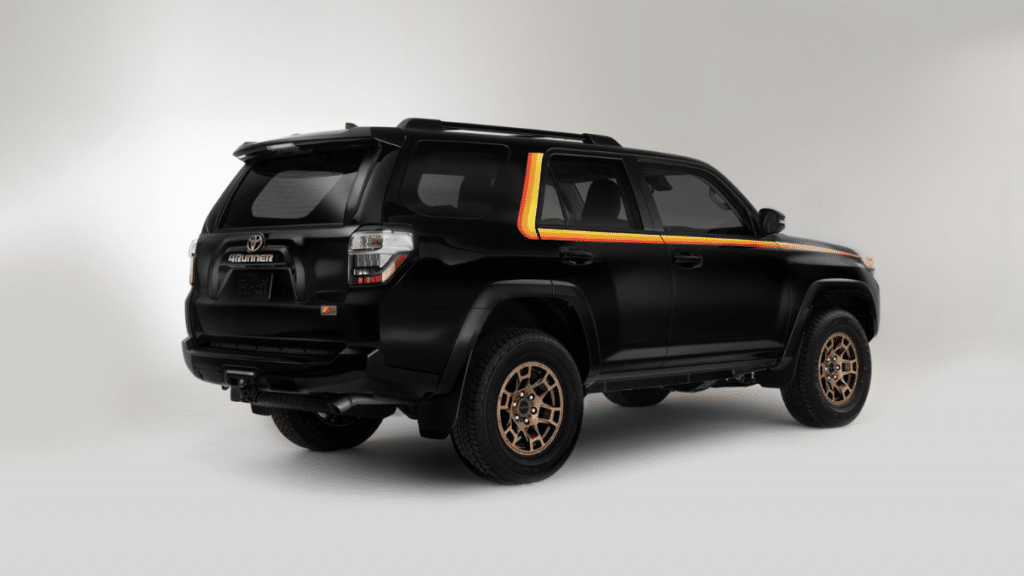Toyota 4Runner-2023 review

In 2023, the Toyota 4Runner will be 40 years old. It belongs to the midsize sector with a length of 190.2 inches, but unlike many of its unibody rivals, it is built with a body-on-frame. Fans like its sturdy and tough feel, simple interior design and controls, and the excellent outdoor capabilities of its TRD Off-Road and TRD Pro trims even though it hasn’t seen a significant change in 14 years, and it shows.
The 4Runner now comes in a 40th Anniversary Special Edition trim available in 4,040 U.S. units and exclusively in four-wheel drive. It has retro-style stripes and a grille. Other new features for 2023 include fresh Solar Octane orange paint, which is only available on TRD grades, a blind-spot monitor with the rear cross-traffic warning, which is standard on all trims, and a rear-seat reminder. The 4Runner is available in eight trims, with the SR5 beginning at $39,555 for a 42 and $41,430 for a 44, without the $1,335 delivery cost. The TRD Sport, SR5 Premium, and Limited are trims featuring both drivelines. The TRD Off-Road, TRD Off-Road Premium, 40th Anniversary, and TRD Pro trims are the only ones available in 44, with the TRD Pro costing the most at $54,020.

While the off-road grades will cross-shop against vehicles like the Ford Bronco or Jeep Wrangler, the 4Runner competes with family-style SUVs like the Ford Explorer, Honda Passport, and Jeep Grand Cherokee. A third row for seven passengers is an option for the SR5, SR5 Premium, and Limited, but with just 29.3 inches of legroom in the back, it’s a pretty tight fit.
A 4.0-liter V6 engine with 270 horsepower and 278 pound-feet of torque is used in all 4Runner grades. It is paired with a five-speed automated gearbox. The ride is stiff and truck-like, with poor handling. The engine is thirsty—it gets just 17 mpg in combined driving, compared to the Ford Explorer’s 23 mpg—but it has been around for a while and is usually regarded as reliable. For the ultimate degree of off-road performance, the TRD Pro trim includes Fox shocks and the locking rear differential found on the TRD Off-Road trims.
The seats are supportive and comfy despite the cabin’s archaic appearance and straightforward controls. Although the second-row legroom in this vehicle is just 32.9 inches, most passengers will find it ample. With up to 47.2 cubic feet of cargo capacity, a broad and squared-off liftgate opening, storage bins above the rear tire wells, and an optional slide-out deck that puts stuff within reach, the 4Runner shines in this area.
Standard driver assistance features include adaptive cruise control, emergency front braking, lane departure warning, automatic high-beam headlights, and the recently added blind-spot monitoring. Although it seems old, the 4Runner nevertheless has devoted followers who value it as the rugged vehicle that it is.
Performance: Toyota 4Runner
A 4.0-liter V6 engine with a five-speed automated gearbox and 270 horsepower and 278 pound-feet of torque powers all 4Runner grades. It is seen as outdated in a category where rival vehicles produce greater strength and have eight to ten-speed gearboxes. Despite this, the 4Runner’s time-tested engine consistently receives top grades for durability and is still strong enough to handle daily driving.
Most trims include a part-time 44 system that may be switched between 4High and 4Low for slick terrains like gravel or thick snow. The Limited is the only vehicle with a full-time system that can be driven on the pavement on four wheels.
The Off-Road variants of the 4Runner have a locking rear differential, adjustable terrain settings, crawl control, and low-speed cruise control for off-road driving, making them stand out among the 4Runner’s four-wheel-drive trims. Fox performance remote-reservoir shocks and skid plates are further additions to the TRD Pro. Although some competitors do better, such as the Jeep Grand Cherokee, which can tow 6,200 pounds, all trims can pull up to 5,000 pounds.
Fuel efficiency: Toyota 4Runner
According to the EPA, the 4.0-liter V6 engine in the 4Runner gets a thirsty 16 mpg in city driving, 19 mpg on the highway, and 17 mpg in mixed driving. Both two-wheel drive and four-wheel drive have the same statistics. It burns gasoline with an octane rating of 87.
Competitors do considerably better. The Honda Passport and Jeep Grand Cherokee have V6 engines, and their combined mileage ratings are 21 and 22, respectively. The Ford Explorer gets up to 21 mpg with its V6 engine and up to 24 mpg with its turbocharged four-cylinder. Even among more challenging off-road vehicles, the Jeep Wrangler gets between 19 and 20 mpg, and although the Ford Bronco’s most brutal Badlands version equals the 4Runner’s 17 mpg in combined driving, other trims get 20 mpg.

Safety and driver support technology:
The National Highway Traffic Safety Administration (NHTSA) only awards the Toyota 4Runner four out of five stars overall in crash tests due to its outdated design. It receives five ratings for side-crash protection, four stars for frontal collision protection, and just three stars for rollover protection. The highest rating from the Insurance Institute for Highway Safety (IIHS) is “Good” for the majority of testing but only “Marginal” for front driver-side overlap crashes and its simplicity when using child seat tethers.
All models have standard features of eight airbags, emergency front braking with pedestrian recognition, adaptive cruise control, lane departure warning, and auto high beams. All grades now come standard with blind-spot monitoring and rear cross-traffic alert, a new feature for 2023.
Comfort and Space
The 4Runner’s 39.2 inches front-seat headroom is exceptionally near to its rivals’ measurements of 39.9 inches for the Grand Cherokee and somewhat more than 40 inches for the Explorer and Passport. The Toyota has 38.6 inches of second-row headroom, compared to competitors’ 39.4 to 40.1 inches.
The 4Runner has more front seat legroom than any other vehicle save the Explorer, which has 43 inches. Though it’s still comfortable for most people in those seats, the second-row legroom is the shortest at 32.9 inches, compared to competitors’ ranges of 38.2 to 39.6 inches. Only 29.3 inches of legroom and 34.3 inches of headroom are available in the third row of the 4Runner. It works well in general for more minor occupants. Although the first and second rows of seats are supportive and pleasant, the interior is loud due to road noise and the engine’s growl.
Infotainment: Toyota 4Runner
An 8-inch infotainment touchscreen is standard in all grades. In cheaper models, onboard navigation is an option, which comes standard in higher trims. All 4Runner models also come standard with a satellite radio trial, Toyota’s Connected Services, which includes trial packages of safety and service connectivity, a Wi-Fi hotspot, and wired Android Auto and Apple CarPlay.
The touchscreen’s aesthetics are outdated, but the system is simple because of its extensive, clear menu icons and firm buttons for opening menus.

Storage & Cargo Space:
Behind the second row of seats in the 4Runner, up to 47.2 cubic feet of storage space is available. This is more generous than the Honda’s 41.2 cubic feet and the Jeep’s 37.7 cubic feet, but on par with Ford’s 47.9 cubic feet. In the Toyota, a third row offers nine cubes of storage space while it’s up and 46.3 cubic feet of storage space when folded down.
The second-row seats in the 4Runner can be folded flat to provide a maximum of 89.7 cubic feet of cargo space, but again, showcasing its age requires two steps. Although it has the advantage of not requiring you to remove the head restraints, you must first fold forward the seat cushion before doing the same with the seatback. Despite no power option, the cargo entrance is broad and squared off once the liftgate is up. The liftgate is hefty. On top of the rear tire wells, there are shallow storage boxes and tie-downs. A sliding cargo deck that extends may be ordered to bring all goods close at hand.
Design: Toyota 4Runner
The whole concept of the 4Runner is that it has a rough, off-road appearance. The Limited features a distinctive front grille with chrome elements, while the 40th Anniversary Special Edition wears its retro-style stripe package exceptionally well. The TRD Pro has a roof rack shaped like a basket and an aluminum front skid plate.
Although the inside of all trims is a little archaic, the extensive, straightforward controls reduce attention. Everything seems sturdy and valuable, and it all fits together nicely.

The Toyota 4Runner 2023: Is It Worth It?
The Toyota 4Runner is a niche vehicle, and customers who want to use it for their off-the-beaten-path outdoor excursions and are prepared to ignore its outdated cabin and increased fuel consumption in favor of its capabilities will probably be the most delighted. While the 4Runner costs $39,555 for the SR5 trim with two-wheel drive and an additional $1,335 for delivery, it costs at least $43,400 for the TRD Off-Road to get four-wheel drive as well as the locking rear differential that gives it the extra capability.
That trim is a solid option for individuals who want a vehicle that can endure daily driving while still getting them to distant camping. The most expensive 4Runner variant, the TRD Pro, costs $54,020 and comes with skid plates and Fox shocks for the absolute roughest things.
How Much Will Insurance for a 2022 Toyota 4Runner Cost?
The insurance expenses for the 4Runner are around typical for its class. The 4Runner TRD Pro is the most costly model to insure, with an average yearly premium of $2,045 for a 30-year-old female driver with a clean driving record. Similar Ford Explorer models would cost $2,122, $2,170 for a Ford Bronco, $2,100 for a Jeep Grand Cherokee, and $1,840 for a Honda Passport.
Verdict
The Toyota 4Runner has been around so long that a 40th Anniversary Edition will be available in 2023. Even though it’s getting on in years, this specialized car still has admirers who value its body-on-frame design, straightforward interior, and rugged off-road prowess in the TRD versions. There is a plus for most of its flaws: It is thirsty but dependable, antiquated yet functional, firm but still comfy, and priced similarly to rivals. It’s not for everyone, but it could be perfect for those who shop in this market.




